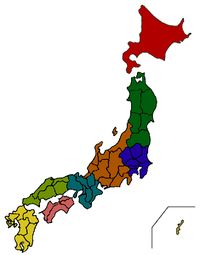Takatō Castle
| Takatō Castle 高遠城 | |
|---|---|
| Ina, Nagano Prefecture, Japan | |
|
| |
| Coordinates | Coordinates: 35°50′00″N 138°03′45″E / 35.8332°N 138.0625°E |
| Type | flatland-style Japanese castle |
| Site information | |
| Open to the public | yes |
| Site history | |
| Built | Sengoku period |
| Built by | Takeda Shingen |
| In use | Sengoku - Edo period |
| Demolished | 1871 |
Takatō Castle (高遠城 Takatō-jō) is a Japanese castle located in Ina, southern Nagano Prefecture, Japan. At the end of the Edo period, Takatō Castle was home to a junior branch of the Naitō clan, daimyō of Iiyama Domain. It was also known as Kabuto Castle (兜山城 Kabuto-jō). Built sometime in the 16th century, it is now largely ruins.[1]
Situation

Takato Castle is located on a hill overlooking the confluence of the Mibugawa River and the Fujisawa River, which forms part of its natural defences. Deep trenches, earthen ramparts and stone walls in concentric rings form the defensive structures in a style typical of construction under Takeda Shingen. The Central Bailey (Hon-maru) [1] was protected to the northwest and northeast by the Second Bailey (Ni-no-maru) [2] and Third Bailey (San-no-maru) [3] along with four enclosures: the Suwa-kuruwa ( 諏訪曲輪 ) [A], Sasa-kuruwa ( 笹曲輪 ) [B], Minami-kuruwa ( 南曲輪 ) [C] and Hōdōji-kuruwa ( 法幢寺曲輪 ) [D]. Most of the gates were box-shaped gates, which added to the defences.
History
The original date of construction of Takatō Castle is unknown, however before its construction, there was originally another fortification on the same site, controlled by the Takatō clan, retainers of the Suwa clan,[2] who had dominated the area since the kamakura period.
The castle was taken by Takeda Shingen in 1545 during his campaign to conquer southern Shinano Province.[3] Takatō Yoritsugu relied on support from his allies, Ogasawara Nagatoki and Tozawa Yorichika, however, they failed to come to his aid.[4]
Under the Takeda clan, the castle was completely rebuilt in accordance with contemporary military design practices. The castle fell to Oda Nobutada, the son of Oda Nobunaga during the Battle of Temmokuzan in 1582, with 50,000 troops as opposed to 3000 defenders on the side of the Takeda clan.
After the Takeda clan was destroyed, the castle was awarded to Mori Hideyori, one of Nobunaga’s generals. However, after the assassination of Nobunaga in the Honnō-ji incident, the area came under the control of Tokugawa Ieyasu, who assigned it to Hoshina Masanao. However, after the Tokugawa clan was reassigned to the Kantō region by Toyotomi Hideyoshi in 1590, Takatō was given to one of Hideyoshi’s generals, Ogasawara Sadayoshi. The Tokugawa recovered the castle following the Battle of Sekigahara in 1603, and with the establishment of the Tokugawa shogunate, Takatō become the center of Takatō Domain, a 30,000 koku holding under the Hoshina clan. The Hoshina were replaced by the Torii clan from 1636-1689, until the assignment of the domain to Naitō Kiyokazu, whose descendants continued to rule to the Meiji restoration.
Following the establishment of the Meiji government and the abolition of the han system, the remaining structures of the castle were dismantled, and its surviving gates donated to nearby temples.[5] The castle site became the Takato Castle Ruins Park (高遠城址公園 Takatōjōshi Kōen), noted for its sakura blossoms in spring. The cherry blossoms were planted in the Meiji Period.[6]
Takatō Castle was listed as one of the 100 Fine Castles of Japan by the Japan Castle Foundation in 2006.
Current situation
Takatō Castle Ruins Park is regarded one of the three best locations to see cherry blossoms, together with Hirosaki Castle and Mount Yoshino.[7] There is very little of the castle remaining in situ aside from part of the moats and stone ramparts. Several of the original castle gates have survived, but are in private hands in other locations. On the site of the castle, the oldest remaining building is the former han school, the Shintokukan (進徳館), built by the last daimyō of Takatō, Naitō Yorinao.
Literature
- Takada, Toru: Takato-jō in: Miura, Masayuki (eds): Shiro to Jinya. Tokoku-hen. Gakken, 2006. ISBN 978-4-05-604378-5 , S. 100th
- Nishigaya, Yasuhiro (eds): Takato-jō. In: Nihon Meijo Zukan, Rikogaku-sha, 1993. ISBN 4-8445-3017-8 .
- Schmorleitz, Morton S. (1974). Castles in Japan. Tokyo: Charles E. Tuttle Co. pp. 144–145. ISBN 0-8048-1102-4.
- Motoo, Hinago (1986). Japanese Castles. Tokyo: Kodansha. p. 200 pages. ISBN 0-87011-766-1.
- Mitchelhill, Jennifer (2004). Castles of the Samurai: Power and Beauty. Tokyo: Kodansha. p. 112 pages. ISBN 4-7700-2954-3.
- Turnbull, Stephen (2003). Japanese Castles 1540-1640. Osprey Publishing. p. 64 pages. ISBN 1-84176-429-9.
External links
![]() Media related to Takatō Castle at Wikimedia Commons
Media related to Takatō Castle at Wikimedia Commons
References
- ↑ http://www.jref.com/articles/the-100-top-castles-of-japan.267/
- ↑ J Castle - Guide to Japanese Castles "Takato Castle" http://www.jcastle.info/castle/profile/129-Takato-Castle
- ↑ J Castle - Guide to Japanese Castles "Takato Castle" http://www.jcastle.info/castle/profile/129-Takato-Castle
- ↑ Ōta, Gyūichi "The Chronicle of Lord Nobunaga" P 433
- ↑ J Castle - Guide to Japanese Castles "Takato Castle" http://www.jcastle.info/castle/profile/129-Takato-Castle
- ↑ J Castle - Guide to Japanese Castles "Takato Castle" http://www.jcastle.info/castle/profile/129-Takato-Castle
- ↑ Takato Castle - Japan Guide http://www.japan-guide.com/e/e6065.html
